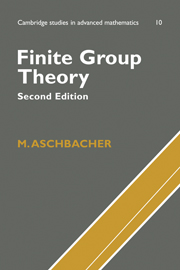Book contents
- Frontmatter
- Contents
- Preface
- 1 Preliminary results
- 2 Permutation representations
- 3 Representations of groups on groups
- 4 Linear representations
- 5 Permutation groups
- 6 Extensions of groups and modules
- 7 Spaces with forms
- 8 p-groups
- 9 Change of field of a linear representation
- 10 Presentations of groups
- 11 The generalized Fitting subgroup
- 12 Linear representations of finite groups
- 13 Transfer and fusion
- 14 The geometry of groups of Lie type
- 15 Signalizer functors
- 16 Finite simple groups
- Appendix
- References
- List of Symbols
- Index
2 - Permutation representations
Published online by Cambridge University Press: 05 June 2012
- Frontmatter
- Contents
- Preface
- 1 Preliminary results
- 2 Permutation representations
- 3 Representations of groups on groups
- 4 Linear representations
- 5 Permutation groups
- 6 Extensions of groups and modules
- 7 Spaces with forms
- 8 p-groups
- 9 Change of field of a linear representation
- 10 Presentations of groups
- 11 The generalized Fitting subgroup
- 12 Linear representations of finite groups
- 13 Transfer and fusion
- 14 The geometry of groups of Lie type
- 15 Signalizer functors
- 16 Finite simple groups
- Appendix
- References
- List of Symbols
- Index
Summary
Section 5 develops the elementary theory of permutation representations. The foundation for this theory is the notion of the transitive permutation representation. The transitive representations play the role of the indecomposables in the theory. It will develop that every transitive permutation representation of a group G is equivalent to a representation by right multiplication on the set of cosets of some subgroup of G. Hence the study of permutation representations of G is equivalent to the study of the subgroup structure of G.
Section 6 is devoted to a proof of Sylow's Theorem. The proof supplies a nice application of the techniques developed in section 5. Sylow's Theorem is one of the most important results in finite group theory. It is the first theorem in the local theory of finite groups. The local theory studies a finite group from the point of view of its p-subgroups and the normalizers of these p-subgroups.
Permutation representations
In this section X is a set, G a group, and π: G → Sym(X) is a permutation representation of G. Recall Sym(X) is the symmetric group on X; that is Sym(X) is the group of all permutations of X. Thus Sym(X) is the automorphism group of X in the category of sets and functions, and π is a representation in that category.
- Type
- Chapter
- Information
- Finite Group Theory , pp. 13 - 21Publisher: Cambridge University PressPrint publication year: 2000



